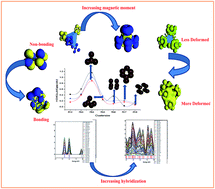Structural evolution, electronic and magnetic manners of small rhodium Rhn+/− (n = 2–8) clusters: a detailed density functional theory study†
Abstract
A systematic investigation on the lowest energy electronic structure of neutral, cationic and anionic Rhn (n = 2–8) clusters in the gas phase is performed with an all electron relativistic method using density functional theory within the generalized gradient approximation. The lowest energy structures of neutral and ionic rhodium clusters are evaluated with different multiplicities. Neutral clusters with even atoms of rhodium and ionic clusters containing odd atoms of rhodium are optimized with multiplicities M = 1, 3 and 5, while neutral clusters containing odd rhodium atoms and ionic clusters with even atoms of rhodium are allowed to relax with multiplicities M = 2, 4 and 6. The bond length, binding energy, coordination number, bond dissociation energy, stability function, ionization potential, electron affinity, electrophilicity, LUMO–HOMO gap, chemical hardness, dipole moment and magnetic moment are evaluated from the lowest energy geometry. These studies reveal that even atom rhodium clusters are more stable than odd atom clusters. Calculated electronic properties such as the LUMO–HOMO gap, bond dissociation energy, stability function, electron affinity and electrophilicity suggest that Rh4 with a tetrahedral geometry is the most stable among all Rhn (n = 2–8) clusters. Hence, tetrahedral Rh4 may be considered as the magic number cluster.


 Please wait while we load your content...
Please wait while we load your content...